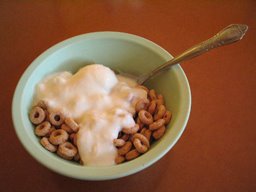
One day I tried to figure out why no one knows how to do anything anymore. We can’t understand, let alone repair, most of the gadgets we use everyday. We increasingly eat packaged and pre-made food; even organic food often comes wrapped in plastic. We don’t know how to grow tomatoes, can peaches, hem pants, or build fences.
As the last generations of depression-era children or back-to-the-landers take their leave of this world, these skills go with them. When we try to learn from scratch we soon discover that recipes in books don’t tell half the story.
I have never found why this knowledge started slipping away from us, but I did start trying to re-learn some of the basics. I now make my own soap, hand lotion, yogourt, and bread. I am trying to figure out toothpaste, but it is hard to find good information on abrasion damage. I also found a great cheese site, and I can’t wait to try it.
I feel great satisfaction when I make things for myself, and I get a surprising amount of cool points when people discover that I can create things usually only found in plastic tubs at the supermarket.
Of these four, yogourt may be the easiest to reclaim, since it was likely discovered accidentally itself, by Arabic nomads some 8000 years ago.
Good yogourt is alive, and the bacteria that make it have remarkable health benefits. Yogourt is produced by the fermentation of lactose, so many people who are lactose-intolerant can eat it. It is good for the digestion, but also for certain infections, and you find it prescribed on all sorts of alternative medicine websites.
It is usually made by sterilizing milk, then adding a bacterial starter culture from powder or other live yogourt. I am lazy, so I make mine straight from powdered milk, with a can of evaporated milk for an Eastern European flavour. I start my first batch with Yogourmet, available in many Middle Eastern delis. Once I have made my first batch, I use the yogourt itself as a starter, just save the last half-cup to start the next batch. You can also buy live yogourt and use it as your starter, but I like the convenience of having freeze-dried bacteria at my beck and call.
YOGOURT
One can evaporated milk
Three cups skim milk powder
Water, 110 degree Fahrenheit, enough to fill up two litre jar
Yogourmet (one sheet, two sachets), or half a cup of live yogurt
I fiddled with my oven until I found a spot on the dial that maintains a pot of water at 110 degrees F. Too hot the bacteria die, too cool and nothing happens. I also leave the oven light on. This may be superstition, or a valid stabilizing heat source, I’m not sure
Mix all the ingredients together in the jar and top up with warm water (I use a Braun stick blender)
Put the bucket of warm yogurt mixture into a big pot full of 110 degree water (your pasta pot or whatever). This provides a temperature buffer, so neither heating nor cooling happens too fast.
Put the pot in the warm oven on the lowest rack. I usually put a couple of cookie sheets underneath, one upside down, so there is a little air pocket to keep the oven element from radiating directly on the pot. This may be overkill, but I am paranoid and I don’t want to toast the bottom of my yogourt. (another yogourt how-to site suggests putting the water bath and yogourt into a camping cooler to maintain the heat. That seems very smart, if you have a big cooler).
Let the proto-yogourt sit for the next 4-6 hours, checking the temperature periodically, and fine tuning the heat. The yogourt firms up as it cools, so don’t worry if it is somewhat sloppy when you take it out.
Refrigerate and enjoy. You can mix in a little (home-made) jam for that fruit on the bottom experience, or check out how to make a cheese spread from your yogourt.
The bacteria theoretically wear out after about 10 batches, but this has yet to happen to me. If I go away for a week or more and the yogourt has been sitting too long, I often just start from Yogoumet again.
The process seems fussy at first, but you will quickly figure out your own method, and then it only takes ten minutes to mix up two litres of yogourt. The hardest part is finding five hours to kill at home. It is great for homework and laundry nights. You can also save your water bath to flush a toilet or water some plants.


0 Comments:
Post a Comment
<< Home